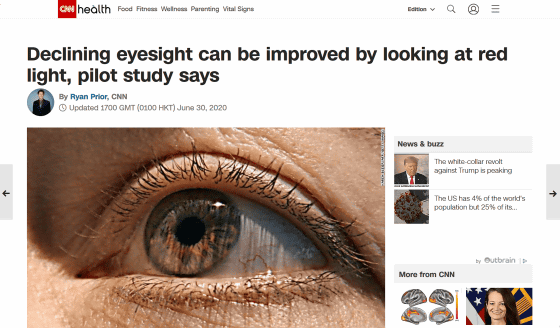Research results that it is possible to improve diminished visual acuity by staring at red light for 3 minutes a day

Although many people are suffering from the deterioration of visual acuity that appears with aging
Optically improved mitochondrial function redeems aged human visual decline | The Journals of Gerontology: Series A | Oxford Academic
https://academic.oup.com/biomedgerontology/article-abstract/doi/10.1093/gerona/glaa155/5863431
Declining eyesight improved by looking at deep red light | UCL News-UCL – University College London
https://www.ucl.ac.uk/news/2020/jun/declining-eyesight-improved-looking-deep-red-light
Declining eyesight can be improved by looking at red light, pilot study says-CNN
https://edition.cnn.com/2020/06/30/health/declining-eyesight-red-light-scn-wellness/index.html

It seems that the human
Mitochondria play a role in producing adenosine triphosphate (ATP), which is involved in the storage and utilization of intracellular energy, and the photoreceptor cells of the retina are the sites with a particularly high mitochondrial density. Therefore, if the ATP produced by retinal mitochondria decreases due to aging, the ATP necessary for the normal functioning of photoreceptor cells will be insufficient, resulting in decreased visual acuity.
'Your retina sensitivity and color vision are gradually diminishing, which is becoming an increasingly important issue as the population ages,' said Jeffrey, stimulating the mitochondria of the retina to diminish. He conducted research to improve the function.

Studies to improve the function of retinal mitochondria to restore visual acuity have been performed for a long time. In experiments on animals such as mice, bumblebees and fruit flies, it was confirmed that the function of the retina improved when exposed to 'deep red light with a wavelength of 670 nanometers'. Regarding this cause, 'mitochondria have certain light absorption properties that affect performance. Absorption of light with a wavelength of 650 nm to 1000 nm improves mitochondrial energy generation capacity.' Says Professor Jeffrey.
To see if this result can be reproduced in humans, the research team conducted a small-scale experiment by gathering 24 men and women without eye diseases. There were 12 men and women, and the age range was 28 to 72 years old. Before the start of the experiment, the research team examined the function of
After that, the research team gave the subject a 'flashlight that emits a deep red light with a wavelength of 670 nanometers' and asked them to train for 3 minutes a day at home for two weeks. Testing the function of photoreceptors again after two weeks of training revealed that the color-identifying cone cell function improved by 14% in all participants and by 20% when restricted to ages 40 and older. In particular, it was confirmed that the ability to discriminate bluish colors, which tend to decline due to aging, was greatly improved. In addition, the team also found that light-sensitive rod cells function significantly better at age 40 and older, the team said.

``Our research improves the energy system of the declining retinal cells by exposing them to light for a short time, just like charging a battery, and significantly reduces the poor vision of the elderly,'' said Jeffrey. It can be improved to.'
The technology used to improve eyesight is simple and safe, and the cost of producing a flashlight that emits red light can be as low as £12. Also, because mitochondria are associated with various age-related diseases such as Parkinson's disease in addition to the loss of visual acuity, we apply a method of activating mitochondria using red light to prevent other health problems. Professor Jeffrey said it could potentially improve.

Related Posts:
in Science, Posted by log1h_ik







